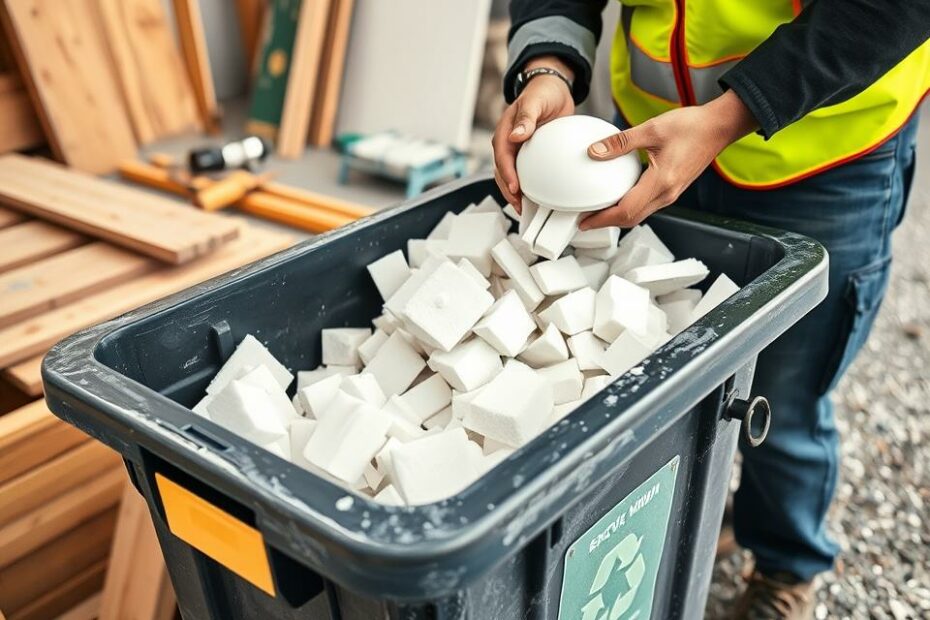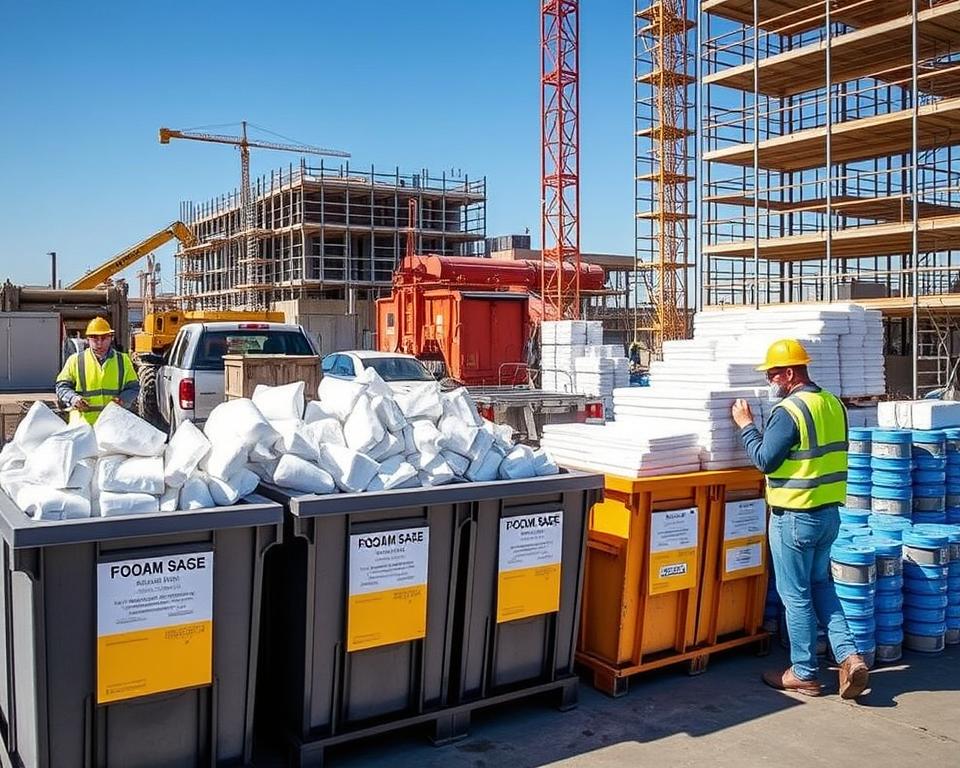I’ve worked in construction for over a decade. I’ve seen the big problem with disposing of construction foam. It’s tough, but I’m here to help you do it right.
Construction foam is key in many building projects. But, getting rid of it wrong can harm the environment and our health. This guide will show you how to do it safely and green.
Understanding the Importance of Proper Construction Foam Disposal
Construction foam waste disposal is crucial for construction pros. Not managing it right can harm the environment and people’s health. It affects both the site and nearby communities.
Environmental Concerns of Foam Waste
Construction foam, like polystyrene and polyurethane, is made from oil and takes ages to break down. If not thrown away correctly, it pollutes and wastes resources. It can also poison soil, air, and water, harming animals and plants.
Potential Health Hazards of Improper Disposal
Bad foam disposal can also hurt people’s health. Workers and nearby folks might get sick from foam chemicals. Breathing in foam dust can cause lung problems, and touching it can irritate skin.
To avoid these dangers, construction sites must use sustainable foam disposal practices. This means managing waste well. Doing so helps keep our environment clean and safe for everyone.
Types of Construction Foam and Their Disposal Requirements
Construction projects use many types of foam. Each has its own way of being thrown away. Knowing how to handle these foams is key for keeping our environment clean.
Rigid foam is a common one. It’s great for keeping things warm or cool. But it must be recycled or disposed of carefully to avoid harming the planet. Polyurethane foam is another big one. It can be dangerous if not thrown away right, because of its chemicals.
| Foam Type | Disposal Requirements |
|---|---|
| Rigid Foam | Recycle or dispose of through authorized hazardous waste channels |
| Polyurethane Foam | Require proper containment and disposal to avoid environmental and health hazards |
| Expanded Polystyrene (EPS) | Can be recycled or disposed of through local municipal waste management programs |
Getting rid of construction foam the right way is very important. It helps keep our planet safe and healthy. By knowing how to handle each foam type, builders can help make our industry greener.
Preparing Construction Foam for Disposal
It’s important to prepare construction foam for disposal the right way. This helps the environment and makes waste management more efficient. Construction teams and site managers need to follow specific steps to handle this waste responsibly.
Separating Foam from Other Materials
The first thing to do is separate the foam from other site materials like metals, plastics, or wood. This step is key for recycling the foam and keeping other waste clean. By separating it well, you help recycle more and reduce waste volume.
Compacting and Packaging Foam Waste
After separating, the foam needs to be compacted and packaged. Compacting it makes it smaller and easier to move. You can use special tools like balers or compactors for this.
Then, the foam should be put in strong bags or containers. This keeps it safe during transport and stops particles from escaping.
By doing these steps, construction teams can prepare construction foam for disposal, separate foam from other materials, and compact and package foam waste. This supports construction site foam waste management and lessens environmental harm.
Dispose Construction Foam: Recommended Methods
Finding the right way to get rid of construction foam is key. There are many eco-friendly options to choose from. These methods help keep our planet clean and promote green practices.
Recycling Options for Construction Foam
Recycling is a top choice for disposing of construction foam. Many places now accept foam for recycling. This turns it into something new or uses it as a raw material. Here are some recycling options to look into:
- Local foam recycling centers: Look for recycling centers in your area that take construction foam. They make sure the foam is used responsibly.
- Take-back programs: Some foam makers and sellers have take-back programs. You can return used foam to them for recycling.
- Foam collection events: Community groups or waste management might hold foam collection events. This is a great way to safely get rid of your foam.
By using these recycling options, you can keep construction foam out of landfills. This helps make foam disposal more sustainable.
It’s important to choose recycling over throwing it away. By doing so, you help lessen the harm to our environment. This is crucial for the future of our planet.
Safe Handling and Transportation of Foam Waste
Managing construction foam waste is key for the environment and worker safety. It’s important to follow best practices for handling and moving foam waste. This ensures safe and responsible waste management.
Safe Handling Protocols
Workers handling foam waste need the right gear, like gloves and masks. This protects them from health risks. They also need training on how to handle and store foam waste safely.
Foam Waste Transportation
Getting foam waste from sites to recycling places needs careful planning. It must be packed and labeled well to avoid spills. Using the right vehicles and routes helps keep the environment safe and the waste delivered properly.
Following these safe handling and transportation practices helps construction companies manage foam waste well. It promotes sustainable foam disposal practices and construction site foam waste management. This protects the environment and keeps workers safe during transportation of foam waste.
Construction Site Best Practices for Foam Waste Management
Managing foam waste on construction sites is key to a green building process. It’s important to have a solid plan for foam waste disposal. This plan should focus on reducing waste, recycling, and proper disposal.
Implementing a Foam Waste Disposal Plan
Creating a foam waste disposal plan is the first step in managing foam waste. This plan should include several important parts:
- Waste Reduction: Teach workers to use foam wisely. This means using less, reducing packaging, and finding new ways to build.
- Recycling: Look for ways to recycle foam waste. This could be sending it to recycling centers or using it for other projects on-site.
- Proper Disposal: Make sure foam waste is handled, stored, and moved safely. This ensures it’s disposed of in a green way.
- Worker Education: Train workers on the value of foam waste management. Teach them the best ways to handle it.
With a good foam waste disposal plan, construction sites can lessen their environmental footprint. This helps make the construction industry more sustainable.
Using green foam disposal practices is good for the planet and can save money. It shows that construction companies care about the environment. They set a good example for the industry.
Eco-Friendly Alternatives to Traditional Construction Foam
The construction industry is looking for ways to be kinder to the planet. This means finding new, green options instead of old foam. These new solutions are better for the environment and can save money for builders.
Natural foam is made from plants or farm waste. It’s good for the planet because it breaks down easily. Plus, it keeps buildings warm or cool, which is great for saving energy.
Recycled foam turns old foam into new stuff. This stops foam from ending up in landfills. It also means less need for new materials, helping the planet.
New ways to recycle rigid foam are coming along. This lets builders recycle foam insulation. It’s a big step towards taking care of our planet.
Choosing green foam shows builders care about the environment. It can also save them money and make buildings better. As more people want green buildings, these new foams will be key to the future.
Regulations and Guidelines for Construction Foam Disposal
Proper disposal of construction foam is crucial for the environment and the law. Construction workers must follow strict rules to handle foam waste safely. These rules come from federal, state, and local governments to protect our health and the planet.
The Environmental Protection Agency (EPA) sets guidelines for foam disposal at the federal level. They tell us how to sort, pack, and move foam waste to the right places. The Occupational Safety and Health Administration (OSHA) also has rules for handling dangerous materials, like foam.
States and local areas have their own rules for foam disposal too. They might ask for special ways to sort and move foam waste. It’s important for construction workers to know these rules and follow them closely.
FAQ
What are the environmental concerns related to improper construction foam disposal?
Improper disposal of construction foam harms the environment. It can pollute the air, soil, and water. This pollution can damage ecosystems and harm wildlife.
What are the potential health hazards of improper construction foam disposal?
Improper disposal of foam can harm people’s health. It can cause respiratory problems, skin irritation, and exposure to toxic chemicals. It’s important to dispose of foam safely to protect everyone’s health.
What are the different types of construction foam and their disposal requirements?
There are many types of construction foam, like rigid foam and polyurethane foam. Each type has its own disposal needs. You need to consider the foam’s chemical makeup, if it can be recycled, and any hazards it may pose.
How should construction foam be prepared for disposal?
To prepare foam for disposal, separate it from other materials. This makes recycling easier. Also, compact and package the foam to reduce its volume and environmental impact during transport.
What are the recommended methods for disposing of construction foam?
Recycling is the best way to dispose of foam. Look for recycling programs and facilities that accept foam. This reduces the need for landfill disposal or incineration.
How should construction foam waste be safely handled and transported?
When handling foam waste, follow safety protocols and use proper PPE. Also, comply with regulations. This ensures foam waste is managed safely throughout the disposal process.
What are the best practices for construction site foam waste management?
Effective foam waste management starts with a comprehensive disposal plan. This includes reducing waste, recycling, and proper disposal. Educate construction workers on the importance of managing foam waste effectively.
What are some eco-friendly alternatives to traditional construction foam?
Eco-friendly foam alternatives are available. These include natural, biodegradable, and recyclable foams. They reduce environmental impact, improve sustainability, and can save construction companies money.
What regulations and guidelines must be followed for construction foam disposal?
Construction professionals must follow laws and industry standards for foam disposal. Stay updated on the latest requirements to minimize environmental and health risks.





